Geoboards are one of the ultimate resources. They are great for even extremely young children. One of my daughters could use one brilliantly when she was only one. They can be used from that age until they are probably at least eight or nine. They develop great fine motor, concentration, and a range of imagination skills. But how do you use them for math?
What are some geoboard math activities? Some excellent geoboard math activities include:
- Symmetry
- Counting
- Patterns
- Pattern snakes
- Multiple-sided shapes
- Making pictures with shapes in
- Put other objects on them, such as curtain hooks or bottle tops
- Add two quantities
- Making different 2D shapes
- Number formation
- Make shapes with certain numbers of sides
- Adding
- Number bonds
- Put shapes inside shapes
- Make abstract shape pictures
- Use lots of different things!
Read on to hear a full description of these activities, brought to life with lots of pictures. I have used a log geoboard for all of these, and I use big multi-colored rubber bands.
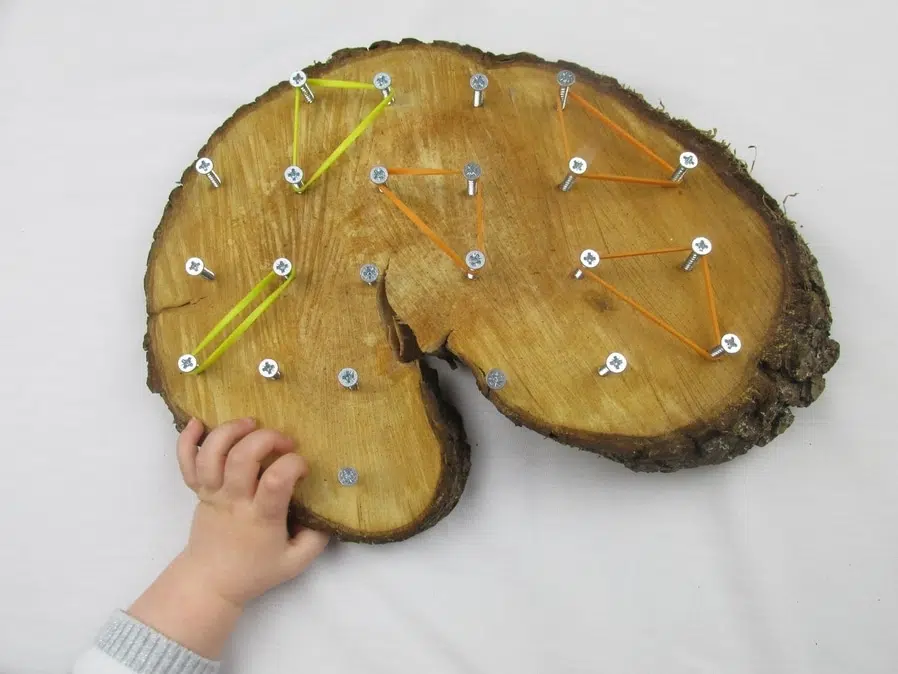
1.Symmetry
Symmetry is a hard concept for many children to get their heads around. Often it is best as something that is explored rather than talked about too much.
Geoboards offer an excellent way of exploring symmetry in an imaginative way. Some children often make everything they do symmetrical anyway. They seem to have some sort of inherent desire to do so.
The idea of this activity is create some sort of shape or shapes on one side of the board. Can you copy it on the other side? It is easier if the shapes are touching each other. It is more difficult if they are apart.
This simple activity just gets them into symmetry, and staring to explore what it is. If you’d like to learn many more symmetry activities, then I have written an in-depth guide of 10 fantastic symmetry ideas that you can check out here.
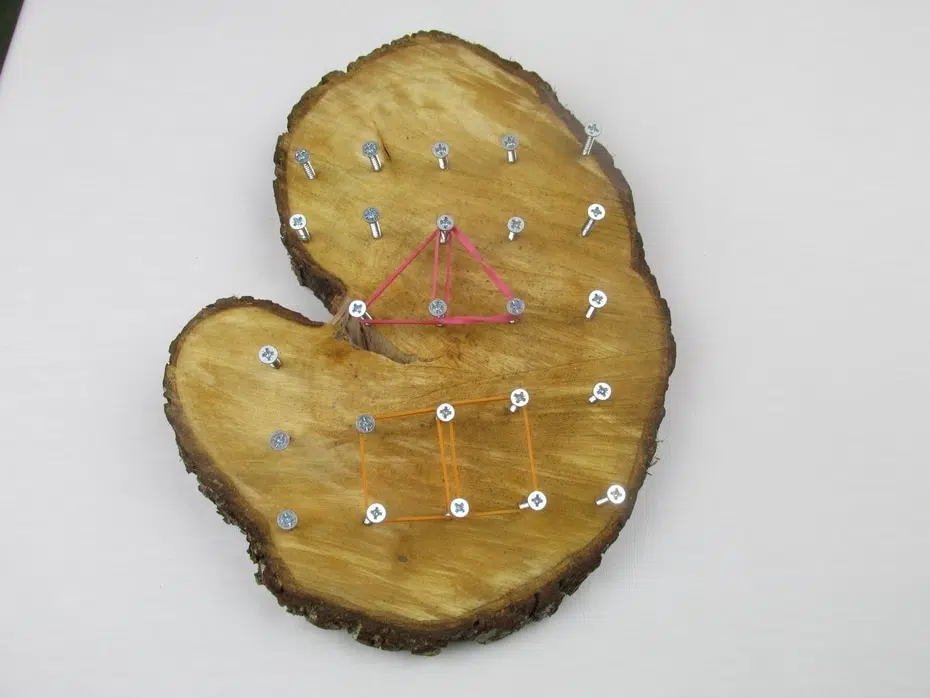
2. Roll The Dice Game
There are so many games you can play that link numeral to quantity, and this skill is one of the core math skills that children need lots of practice in. It also includes 1 to 1 correspondence, another central skill. To find out all about what 1 to 1 correspondence is and the best ways to teach then check this article out.
They also, thankfully, usually really like using dice. Especially if it is some sort of ‘special’ dice like the wooden one that I like to use (sawn from a fence post).
Simply roll the dice and then try to put that number of rubber bands on the log.
If several children try it at the same time on different geoboards, it is amazing the quantity of different arrays that they can make. The number six, for example, can be represented in so many different ways.
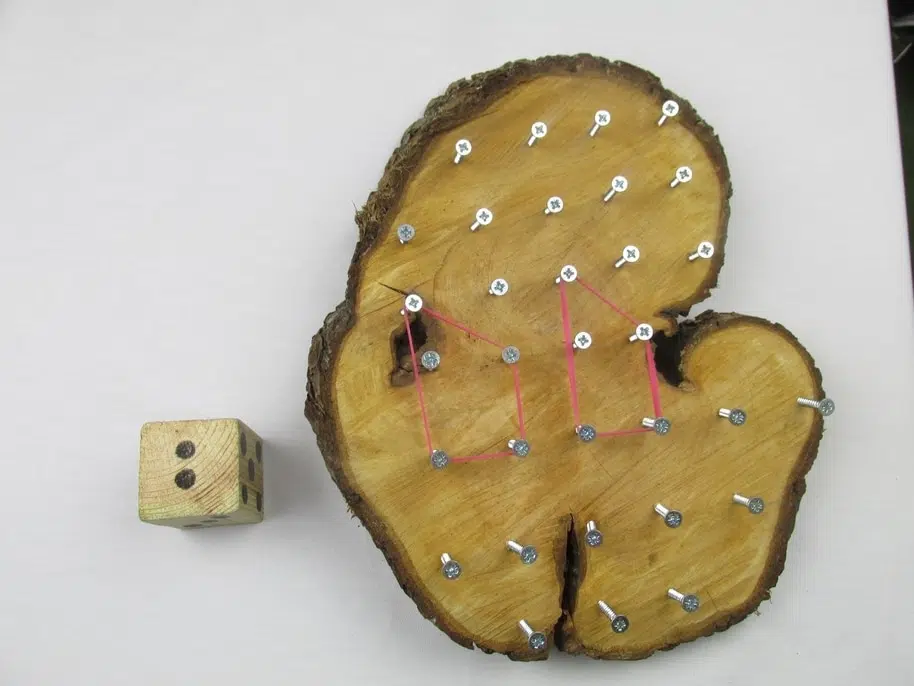
3.Make Patterns
I think the more practical the activity the better with patterns. If it is hands-on, and the children get to manipulate objects in some sort of way, they are much more likely to understand what a pattern is.
The simplest way to make a pattern is to use two colors of rubber bands. Put one on the geoboard in some sort of way, and then put the next color on beside it. For example, it could go blue, green, blue, green etc.
The bands can be put on in any sort of way. They could be squares or triangles, or just lines. Whatever you like.
If the children are good at this, then you can extend this activity by making them attempt more complex patterns. It could be blue, blue, green, blue, blue, green for example.
Or the pattern could contain three or four colors. Go for it!
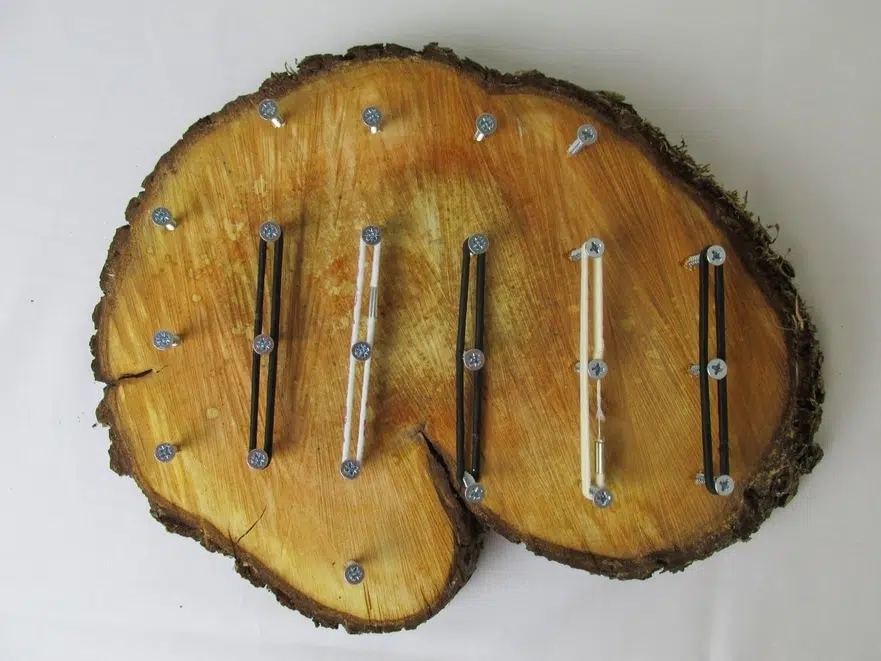
4. Pattern Snakes
Children really like anything to do with snakes, and these simple snakes are brilliant for teaching patterns. You can use mini-loom bands for these snakes, or stick to the bigger colored rubber bands.
Again, it is a good idea to limit the children to two colours. The simpler the better when you are starting out with patterns.
Put one color of loom band between two screws. Then follow it with a different color, then back to the first. You will start to create a multi-colored snake that can wiggle all around the geoboard.
5.Make Shapes With Lots Of Sides – Silly Shapes
This is an excellent task for fine motor, and also great for math because it really gets them thinking. Big rubber bands are perfect for this – the bigger the better because then you can really stretch them out across the whole board.
Just put a band, and then start stretching it in all sorts of ways over the board. You will get a giant, silly shape, that is usually completely irregular.
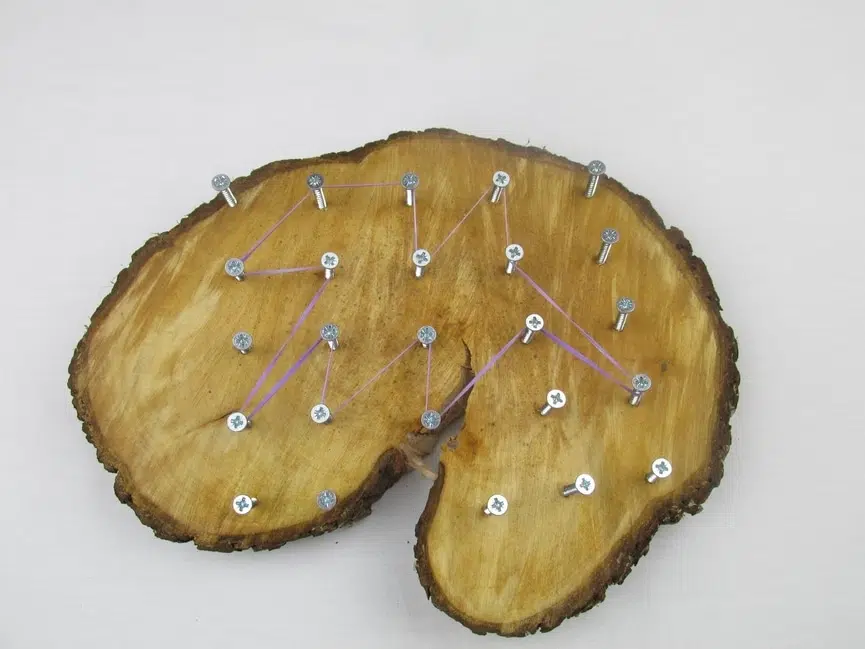
When you have made the shape you can try to count the sides. Or you can try and make it even sillier.
This one taps into children’s sense of silliness, and having fun with shapes is a great thing.
6.Make Pictures
This is an activity that lots of children will do instinctively, and one they can really get into and get into the zone.
You quite simply get them to make pictures with the rubber bands, or loom bands, or whatever it is you are using.
The pictures will have lots of 2D shapes in. It is impossible to use the geoboards without this happening. You can talk about the shapes they find and make as they go.
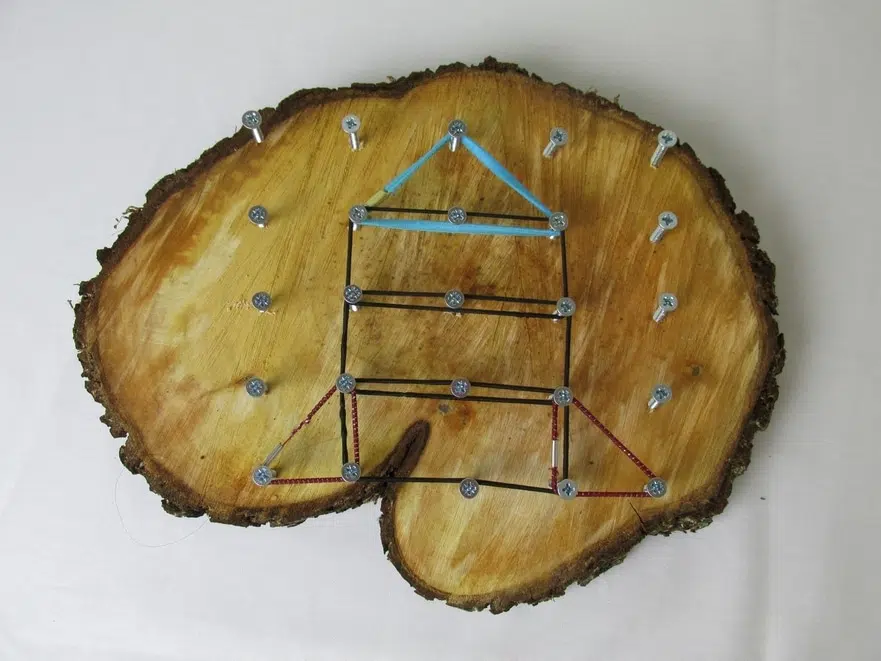
Common pictures you will see will be houses and people, but of course there will be all sorts of random things as well, and the more random the better. It could be a rocket. Or santa’s sleigh. Let their imaginations go for it.
7. Put Other Objects On The Geoboards
Whatever activities you do can definitely be enhanced by putting other objects onto the boards as well.
Good things to use might be bottle tops to balance on the tops of the screws, or curtain hooks, or corks. You could intertwine pieces of wool into the rubber bands, or you could add simple natural materials like leaves, grass, or twigs.
Loose parts play like this is open-ended and really beneficial in many ways. If you want to find out the kind of materials you can use for loose parts, then have a look at my article about the best 100 materials you can use for it.
There could be many purposes to this. It could just be simple weaving.
It could be to help them create a picture. The bottle tops could be two eyes, for example, in the robot they have made.
The objects can also help them count. For example, if they have made a triangle, they could put one curtain hook on each corner of the object. This helps them to then count the corners, and brings what a corner is in to sharper focus in their minds.
You could stack objects in arrangements, or use them as part of patterns.
The possibilities really are endless. It is great to use a range of objects with children in a child-led context and just see what they come up with.
8.Adding
It is great to experiment with adding in a range of ways to really embed children’s knowledge in this area.
Why not add with a geoboard?
Get two colors of rubber bands, and two dice. If you have a two colors of dice that match the rubber bands then that will work really well – e.g. a blue dice and blue bands, and a red dice and red bands.
Then get the children to roll the two dice. Put that number of bands onto the board in some kind of way.
It is amazing to see the imaginative ways in which they build the arrays!
Then, when they have them on, they can count up how many bands there are altogether. This is really visual and physical mixed together, and just an engaging way to explore addition.
You can extend it by using numbers higher than six on a standard dice, and also by using three dice, and three colors of bands.
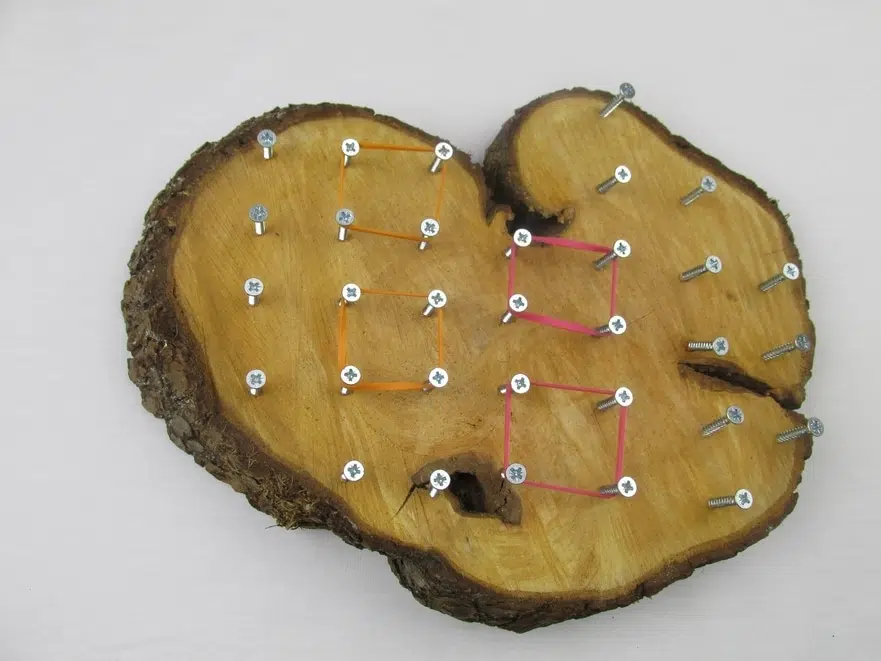
9. Make Different 2D Shapes
This is an old classic, and one of the most popular geoboard activities.
You can try to make a triangle, a squash, a rectangle, a pentagon.
A great way to explore the different shapes. You can make shapes of different sizes. See how big or small you can make them. A simple, but really good fun way of exploring this area.
10. Number Formation
In this activity, you use the bands to create numerals. It is a good way for young children to think about how the numbers are formed, and also presents enough of a challenge to get them thinking and problem solving.
Thinking about number formation in many different contexts is a great way to recognize numerals. To read the best 16 games to help recognizing numbers then take a look at this.
Some numerals are simpler to try to create than others. Number one, for example, couldn’t really be simpler. Just one band in a straight line will do the job.
Number four, on the other hand, takes a lot more thinking, and may well take multiple bands to get the job done.

This activity could potentially be extended to letter formation also.
Also, you could try to create a sequence of numbers, e.g. 1,2,3 on the geoboard.
11.Make Shapes With Certain Numbers Of Sides
This activity requires a bit of creativity and the ability to have a go.
It is nice, in this to roll a dice. Ideally, if you have a dice with numbers from 3 to 8, then that would work perfectly.
If not, just ignore the 1 and the 2, as they don’t really work in this game. It is impossible to create a shape with 1 or 2 sides on a geoboard. Circles and semi-circles simply don’t work, so it is best to start at 3.
The idea is that you spin the dice, and whatever it lands on then you try to make a shape with that number of sides.
For example, if it lands on 5, you will be trying to make pentagons. It is amazing the vast number of different pentagons you can make!
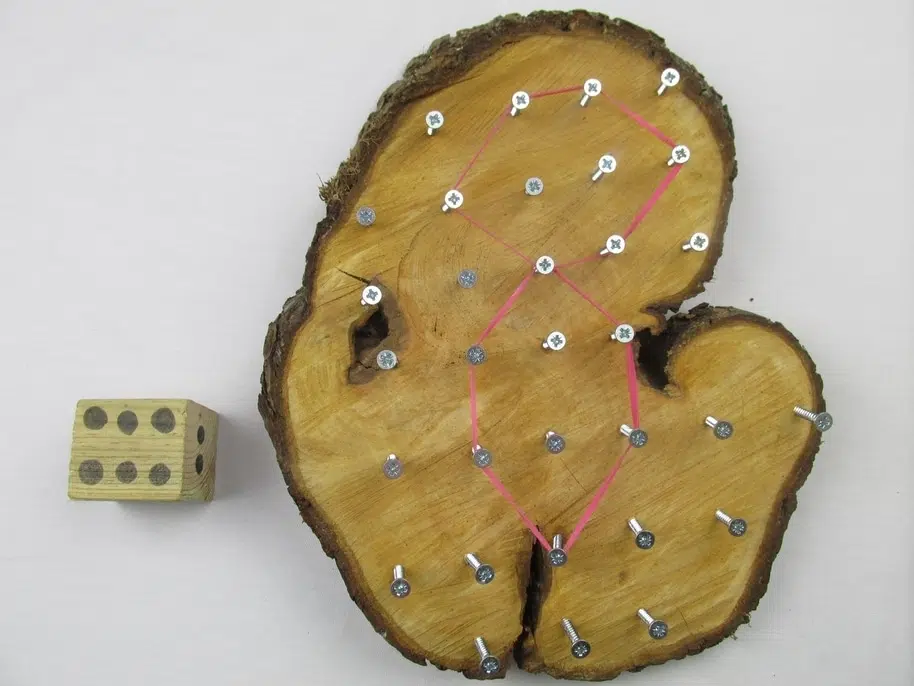
The larger the numbers get, the more scope you have for different numbers of combinations. When you get to 8, the quantity of different octagons that are possible is staggering!
If children are struggling to make these larger shape quantities, then just stick with triangles and squares.
12. Number Bonds
Number bonds are another thing that it is good to experiment with in a range of ways. The more methods children have at their disposal to help them visualize number-bonds the better, and geoboards are fantastic for this.
Starting with number bonds to five is almost certainly the way to go.
Have two colors of bands, and tell the children that we can use five bands on the board at one time.
Then let them have a go at making different ‘fives’. They will have all sorts of combinations of colors, e.g. 4+1, 2+3 etc. They will also come up with lots of ways of putting the bonds in arrays. It could be triangles all over the board, or squares, or a mish mash of all sorts of things.

This creative approach to number bonds really brings it alive, and makes it something that inspires them to talk as they go.
13. Put Shapes Inside Shapes
This is a great way of thinking about size, and also beginning the process of understanding area and perimeter.
Make a small shape in the middle of the geoboard. A triangle is a good, simple place to start.
Then create a larger triangle around the first. Then a larger one again. Continue until you can go no bigger!
It is great for them to see the shapes getting bigger, and start to understand about the space inside the different shapes, as well as the perimeter of their sides.
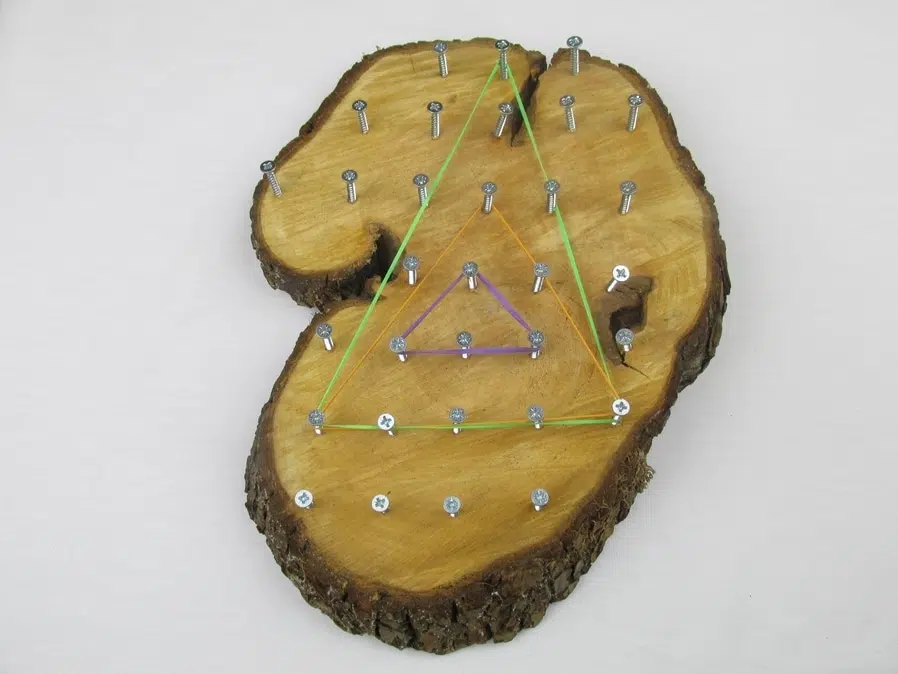
14. Make Abstract Shape Pictures
This is what usually happens if you just let children go for it without any direction. You will get a random assortment of different abstract shapes, and this is one of the best ways of exploring 2D shapes, and just letting your mind become accustomed to the possibilities in creating them.
This is probably the kind of way a geoboard is used the most, as young children should be learning more through their own experimenting than adult-led.
Children will start to understand the ‘squareness’ of squares, and the ‘triangleness’ of triangles if they are just left alone to experiment and find out for themselves.
15. How Many Types Of Triangles Can You Make?
Triangles are excellent as a starting point for this activity, but it can also definitely be extended to shapes with more sides than a triangle.
The idea is to say, we are going to try and make lots of triangles that all look different.
There really are so many that children can come up with.
Through experimenting they will possibly come up with right-angled triangles, isosceles triangles, scalene, obtuse, and all the other variants.
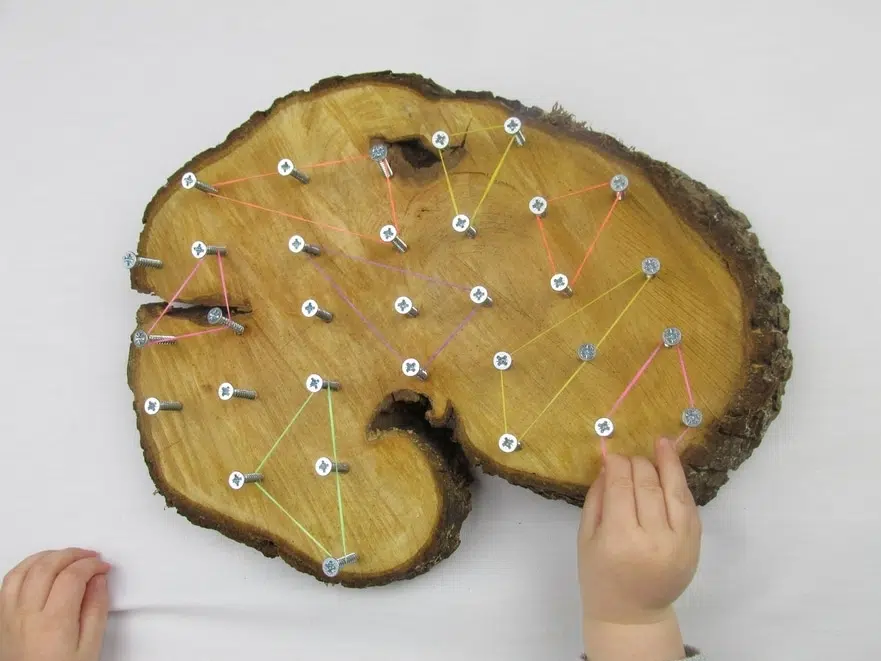
They almost certainly will have no idea that this is what they are doing, but they are starting this process in their mind, and visualizing the many possible triangles that exist in the world.
Geometry is built around triangles to some extent, and this simple activity gives children an excellent starting point to explore then properties.
16.Use Different Items
I really do like using the large colored rubber bands for geoboards, but these are far from the only options.
Loom bands are excellent also, and you can buy loom-bands extremely cheaply these days, since they have declined in popularity.
Another item to give a go is hair bobbles.
A mixture of different objects is great for child-led exploration. Also adding other objects to enhance their experience is great too – for example, material or simple loose parts.
How Do You Make A Geoboard?
Geoboards are super easy to make, and only a few DIY skills are required. My favorite geoboards are made out of big log slices.
If you can’t find or buy one of these, then you can use a small log, or a even just any offcut of wood from the local hardware store.
I like to use screws on the geoboards, preferably ones with large ends, so children will not get hurt if they face-plant the board by mistake!
However, you can also use nails hammered into the wood. Again, go for nails with large ends, and make sure they are hammered well into the wood, and can’t come out.
I like to put the screws in regular rows, but random geoboards are great too. You can just do different things on each.
If DIY is not for you, then you can just buy a geoboard. Plastic geoboards work fantastically, and are probably even easier to store. They are light and can be transported simply.
Conclusion
So why not give some of these geoboard math activities a go!
Geoboards are brilliant for supplying a multitude of early geometry and shape skills, though children often have no idea they are doing that!
You can use them for counting, adding and making patterns.
Most importantly, geoboards are fun, and children just have an innate desire to fiddle with them!
Good luck trying them out!
If you’ve enjoyed this article, then why not try one of these:
